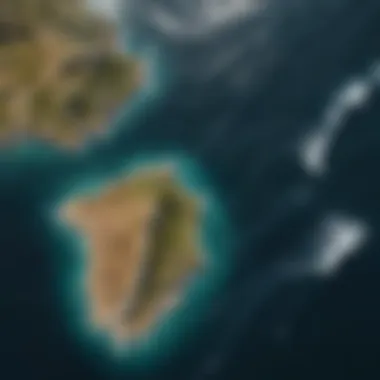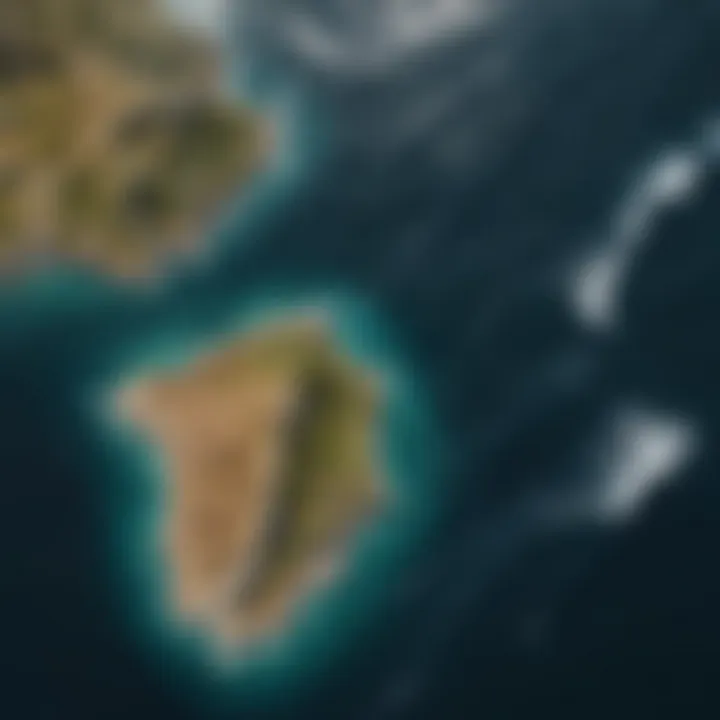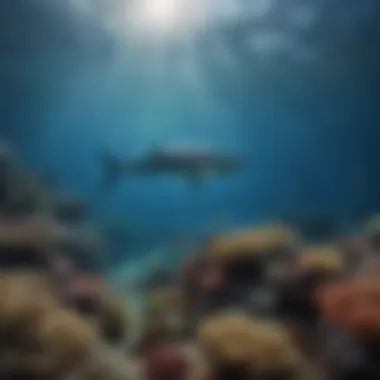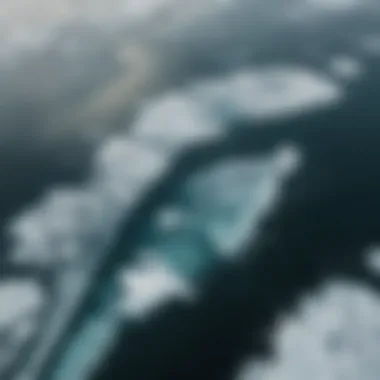Examining the Earth's Four Major Oceans


Intro
Oceans make up a remarkable part of our planet, covering over 70% of its surface. These vast bodies of water are not just empty blue expanses—they are complex ecosystems with uncountable life forms, intricate weather patterns, and critical economic resources. The Earth's four major oceans—the Atlantic, Pacific, Indian, and Arctic—each have distinct characteristics that influence everything from global trade to climate change.
The Atlantic Ocean, often recognized as a bridge between continents, holds keys to historical maritime routes. The Pacific Ocean, the largest, expands beyond our imagination and supports some unique ecosystems. On the other hand, the Indian Ocean, which connects many developing nations, plays a vital role in global commerce and fisheries. Lastly, the Arctic Ocean, with its fragile ecosystems and ice-covered waters, speaks volumes about climate change’s ominous impact.
Understanding these oceans goes beyond mere geography; it includes their ecological significance, economic values, and how they interact with human activities. As we explore these vast waters, we will look at how they shape both the environment and our daily lives. This journey through the oceans will also uncover the importance of conservation efforts in preserving these crucial resources for future generations.
Prologue to Earth's Oceans
The vastness of Earth's oceans can hardly be overstated. Covering more than 70 percent of the planet’s surface, these expansive bodies of saltwater are not just a backdrop for our life; they are fundamental to it. In this exploration of the Earth's oceans, we bring focus to their significance, relationships with the land and air, and ways they shape our planet's destiny.
Understanding oceans goes beyond mere curiosity. They are vital to our existence. From providing food through fishing industries to regulating climate and weather, their roles are multifaceted and profound. Oceans function as the lungs of the Earth, generating more than half of the oxygen we breathe. This aspect alone places enormous importance on protecting and understanding them. Additionally, oceans help maintain the planet's temperature, absorbing heat and distributing it globally through currents.
The Importance of Oceans
Oceans are not merely vast saline expanses but also dynamic ecosystems that teem with life. They offer countless resources, such as fish, minerals, and even energy sources. Importantly, they influence and moderate our weather systems and climate patterns.
The scope of oceanic impact spans various sectors:
- Biodiversity: Oceans are home to an astounding variety of life forms, from the tiniest plankton to the largest whales. This rich biodiversity is crucial for ecological balance and provides countless benefits, including pharmaceutical resources derived from marine organisms.
- Climate Regulation: Oceans play a pivotal role in the water cycle and climate regulation, absorbing carbon dioxide and acting as heat reservoirs. Their condition can directly affect global warming, making their study essential.
- Economic Value: The economic impact of oceans is enormous. They are critical for trade, tourism, and industries like fishing and aquaculture. This economic aspect intersects directly with conservation efforts, urging a balance between use and preservation.
Geographical Distribution
Diving into the geographical distribution of oceans, we see how they are divided into five primary regions: the Pacific, Atlantic, Indian, Southern, and Arctic Oceans.
- Pacific Ocean: The largest and deepest ocean, it stretches from the Arctic in the north to the Antarctic in the south. It hosts a variety of ecosystems and geographic features, such as the Mariana Trench,
- Atlantic Ocean: Known for its two major divisions, the North Atlantic and South Atlantic, this ocean is rich in historical exploration and trade routes critical to many countries.
- Indian Ocean: Bordering major continents, this ocean has a unique mix of warm waters and significant trade conduits, including the Strait of Malacca.
- Arctic Ocean: This ocean is unique due to its polar location, containing significant ice coverage and ecosystems that are particularly sensitive to climate changes.
Understanding the geographic distribution of these oceans helps illustrate not only their size and depth but also their varied ecosystems and how they interact with human activities and the global environment.
"The ocean stirs the heart, inspires the imagination, and brings eternal joy to the soul."
Rigorous investigation and respect for these aquatic realms are necessary because the future of our planet depends largely on the health of our oceans. Engaging with their complexities sets the stage for more in-depth exploration in the sections that follow.
The Pacific Ocean
The Pacific Ocean is not just the largest ocean on Earth; it is also a critical part of the planet's relationship with life and economy. Covering over 63 million square miles, it plays an indispensable role in regulating climate, supporting a rich array of marine life, and facilitating global trade. The Pacific is often seen as a vast blue expanse, but within its depths lie treasures and challenges that impact not only nations bordering it but the entire globe.
Geographical Features
The Pacific Ocean is home to a myriad of geographical features that shape its unique character. It contains the Mariana Trench, the deepest point on the planet, measuring about 36,000 feet. This trench is a profound reminder of the Pacific's incredible depth and complexity. Along with deep-sea regions, the ocean boasts numerous island chains, such as the Hawaiian Islands, which are known for their volcanic origins. The sheer size of the Pacific allows for different climatic zones, from tropical areas in the south to temperate climates in the north, each with its own ecosystems. This geographical diversity contributes to the Pacific's prominence in this article, warranting our attention in understanding how these features support life.
Biodiversity Hotspots
The Pacific Ocean is a biodiverse wonderland, known for its incredible variety of ecosystems. Areas with distinctive environmental conditions result in unique habitats that teem with life.
Coral Reefs
Coral reefs, often referred to as the "rainforests of the ocean", cover about 1% of the ocean's surface, yet they host around 25% of all marine species. They play a crucial role in providing habitat for countless marine organisms. The great barrier reef, which lies off the coast of Australia, is prominently featured in discussions about coral health due to its vibrant life and ecological significance. However, coral reefs face numerous challenges, such as bleaching caused by climate change. This characteristic makes them a key focus of this article, as understanding their plight is essential for global marine conservation efforts.
Marine Sanctuaries
Marine sanctuaries are designated areas that provide protection to marine organisms and habitats, allowing ecosystems to thrive free from human interference. The Pacific is dotted with numerous marine sanctuaries, such as the Papahānaumokuākea Marine National Monument in Hawaii, which preserves an estimated 582,578 square miles of ocean and culture. These sanctuaries help maintain biodiversity and protect endangered species. The unique feature of these sanctuaries is their role not only in conservation but also in cultural heritage, showcasing the deep relationship between the ocean and indigenous communities. In this article, marine sanctuaries highlight the balance we must find between economic development and ecological sustainability.
Economic Impact
The Pacific Ocean does not only serve as a natural habitat; it is a significant driver of the global economy as well. Its resources and routes shape the trade practices and livelihoods of many nations.
Fishing Industries
Fishing industries in the Pacific offer a wealth of resources, from tuna to shellfish, contributing significantly to local and global economies. Countries like Japan and the U.S. lean heavily on these resources for food security. However, there are concerns regarding overfishing and the need for sustainable practices to ensure the health of fish stocks. The unique aspect of the Pacific fishing industry is the integration of traditional practices with modern techniques, providing a rich tapestry of economic and cultural narratives that underscore its importance.
Trade Routes
Trade routes across the Pacific are critical for global commerce, supporting billions of dollars in trade each year. Major shipping lanes run through this ocean, connecting markets in Asia, North America, and beyond. The unique feature of these routes is the efficient movement of goods over vast distances, which grapples with challenges like piracy and environmental hazards. Including Trade Routes in this article allows for a comprehensive understanding of how the Pacific not only connects people but also facilitates a global economy that needs to recognize its environmental responsibilities.
Climate Influence
The Pacific Ocean plays a multidimensional role in influencing global climate patterns, often serving as a bellwether for environmental changes.


El Niño Phenomenon
El Niño is a climate pattern that originates in the Pacific, impacting weather systems across the globe. This phenomenon can cause significant temperature variations and has been known to disrupt agricultural practices and cause extreme weather events worldwide. The unique feature of El Niño is its ability to demonstrate the interconnectedness of different climates and weather patterns, making it a significant topic in climate discussions. Understanding El Niño in this article provides insight into how human-driven climate change can exacerbate its effects, thus highlighting the need for better environmental stewardship.
Weather Patterns
The weather patterns associated with the Pacific are vast and influential, impacting rainfall, droughts, and storms across multiple continents. The Pacific Ocean's currents drive significant global atmospheric circulation, which in turn affects weather conditions. The key characteristic here is the oscillation between wet and dry spells, shaping ecosystems and agriculture. Examining these weather patterns allows us to appreciate the delicate balance of our planet's climate system, making it an important aspect of this article to lay emphasis on.
The Atlantic Ocean
The Atlantic Ocean plays a critical role in our understanding of global dynamics, being the second largest ocean on the planet. This body of water acts as a bridge between continents and houses some of the world’s most vibrant ecosystems. For athletes and adventurers, the Atlantic isn't merely a geographical feature; it's a resource that influences weather systems, trade routes, and marine life, serving both exploration and conservation efforts.
Geographical Features
The Atlantic stretches from the Arctic Ocean in the north to the Southern Ocean in the south, bordered by Europe and Africa on the east and the Americas on the west. Its diverse landscape includes deep trenches like the Puerto Rico Trench and vast plateaus that can host unique geological formations. This variety affects ocean currents, shaped by the wind, Earth's rotation, and salinity.
Notably, the Gulf Stream, a warm ocean current, originates in the Gulf of Mexico and flows up the U.S. East Coast, impacting weather dramatically. It not only warms European climates but affects storm patterns and marine migration as well.
Biodiversity Assessment
Unique Marine Life
The Atlantic Ocean is home to remarkable marine creatures like the Atlantic bluefin tuna and North Atlantic right whale, both known for their unique adaptations. These species are often sought after for their significance in ecosystems and economic value. For instance, the bluefin tuna’s speed and size make it a top predator, influencing the populations of smaller fish. Nevertheless, its popularity in sushi restaurants leads to overfishing concerns, emphasizing the delicate balance between human consumption and conservation efforts.
The distinct feature of the North Atlantic right whale is its unique callosities, which are rough patches of skin that serve as a distinctive marker for researchers tracking their populations. Unfortunately, these whales are endangered due to ship strikes and fishing gear entanglement, demonstrating the severe impact of climate and human activity on biodiversity.
Deep-Sea Ecosystems
Exploring the deep-sea habitats of the Atlantic unveils astonishing biodiversity not commonly witnessed. Hydrothermal vents, for instance, host extremophiles—organisms that thrive in harsh conditions. These ecosystems are vital for understanding how life can exist in extreme environments, offering insights into potential life on other planets.
The unique feature of these vents is that they support entire communities based on chemosynthesis rather than photosynthesis, contrasting with most life on Earth. These systems provide a glimpse into the resilience of life and the importance of preserving such habitats from deep-sea mining or pollution, reminding us of the interconnectedness of life.
Economic Significance
Tourism Opportunities
Tourism on the Atlantic coasts thrives, from the beaches of the Caribbean to the historical sites in Europe and the bustling ports of North America. The coastal beauty coupled with marine habitats draws millions annually for both recreational and educational experiences.
A particular feature of Atlantic tourism is eco-tourism, which provides generous opportunities to educate visitors on conservation while supporting local economies. The potential downside, however, lies in overcrowding and environmental degradation, making responsible practices crucial.
Resource Extraction
The Atlantic Ocean is also a treasure trove of natural resources, including oil, gas, and minerals. Major offshore drilling projects have emerged, particularly around the North Sea area, driving economic growth but raising significant environmental concerns.
This unique characteristic of resource extraction must be approached with caution; it offers benefits for energy needs yet risks oil spills, habitat destruction, and long-term ecological shift, reminding us of the need for sustainable methods in resource management.
Climate Dynamics
The Atlantic Ocean plays a pivotal role in global climate. It fosters the Atlantic Meridional Overturning Circulation (AMOC), a critical component of Earth’s climate system. Through this, warm and cold water currents interact, stabilizing climate patterns across continents.
Changes or disruptions in the AMOC due to climate change can lead to severe weather events and rising sea levels, affecting coastal communities. Thus, understanding these dynamics is essential not only for the survival of marine life but for human populations relying on the ocean’s stability.
The Indian Ocean
The Indian Ocean, the third-largest ocean on Earth, plays a pivotal role not only in regional dynamics but also globally. Its waters stretch across diverse geographies, spanning several countries and cultures. The importance of the Indian Ocean is multifaceted; it’s a crucial conduit for international trade, supports unique marine biodiversity, and heavily influences climate patterns in surrounding regions. Understanding this ocean is essential, given its substantial impact on the environment and economy.
Geographical Features
The Indian Ocean is bordered by Africa, Asia, Australia, and the Indian subcontinent. It features a mix of warm waters and complex currents that significantly shape its coastal geography. Notable geographical features include the Arabian Sea, the Bay of Bengal, and the Great Reef along Australia. These areas not only serve as vital ecosystems but also hold immense economic significance due to their rich resources and strategic positioning for maritime trade.
Ecosystem Variety
Marine Protected Areas
Marine Protected Areas (MPAs) in the Indian Ocean are essential for conserving unique marine habitats. They protect vital ecosystems like coral reefs and mangrove forests, crucial for maintaining biodiversity. Key characteristics of MPAs include restrictions on fishing and other activities that can harm the environment. The beneficial aspect of MPAs lies in their ability to preserve marine life, promote healthy fisheries, and foster resilience against climate change. A unique feature of MPAs is that they allow scientists to study ecosystems relatively undisturbed, providing invaluable insights. However, establishing MPAs can sometimes face challenges, such as local resistance or lack of resources for enforcement.
Endangered Species


The Indian Ocean is home to various endangered species, including the critically endangered Hawksbill turtle and several shark species. Protecting these species contributes to the overall ecological health of the ocean and highlights the key characteristic of biodiversity conservation. Their presence indicates a healthy marine environment, which is a beneficial aspect for fisheries and tourism alike. The unique feature of these species in the Indian Ocean is that they often rely on specific habitats, making their protection critical. However, the threats from fishing and habitat degradation pose significant challenges for their survival.
Economic Contributions
Shipping Industries
Shipping industries in the Indian Ocean are a fundamental part of the global economy, facilitating trade between continents. This ocean is a vital trade route for oil and gas shipments, which underscores its key characteristic as a major link in maritime logistics. Its beneficial role in the global supply chain cannot be overstated. The unique feature of the Indian Ocean's shipping industry is its strategic chokepoints, like the Strait of Hormuz and the Malacca Strait, which significantly influence global trade dynamics. Despite its advantages, challenges such as piracy and geopolitical tensions persist, threatening this economic lifeline.
Aquaculture
Aquaculture in the Indian Ocean represents a significant economic opportunity, providing sources of protein to many coastal communities. This sector is noted for being a beneficial way to meet growing food demands while alleviating pressure on wild fish stocks. The unique feature of aquaculture in this region includes diverse farming practices that adapt to local conditions, offering tailored solutions. However, it also faces challenges, including the need for sustainable practices to prevent environmental damage and ensure long-term viability.
Influence on Climate
Monsoon Patterns
The Indian Ocean's influence on monsoon patterns is profound. The Indian monsoon, driven largely by warm ocean currents, feeds vast agricultural regions. Key characteristics of these patterns include seasonal rainfall that affects millions of lives. For this article, understanding monsoon dynamics is crucial as they underpin food security in the region. A unique feature of these patterns is the intricate link between ocean temperatures and rainfall – warmer waters can intensify monsoons, leading to both benefits and challenges, such as flooding.
Ocean Currents
Ocean currents in the Indian Ocean play a significant role in regulating temperatures and influencing weather patterns. These currents can impact not just local climates but also those of distant regions. The beneficial aspect of these currents lies in their capacity to disperse nutrients, thus supporting marine life and fisheries. A unique feature of these ocean currents is their seasonal variations, which can lead to distinct ecological phenomena, like upwelling zones that attract abundant marine life. However, climate change poses challenges, altering these currents and the systems they support.
The Arctic Ocean
The Arctic Ocean, though often overshadowed by its larger neighbors, holds immense importance in our planet's ecology and climate systems. Stretching over the northernmost part of Earth, this ocean has unique characteristics that play a crucial role in understanding the broader context of global climates. Covering an area of about 15 million square kilometers, it influences weather patterns, ocean currents, and even sea levels.
Geographical Features
The Arctic Ocean is characterized by its shallow continental shelf, which facilitates the growth of various marine ecosystems. Particularly notable is the presence of sea ice, which forms during the winter months and melts during summer. This dynamic ice cover is not just a geographical feature; it's a vital part of the ecological system that supports various species. The ocean's coastline is lined with several countries, including Canada, Greenland, Russia, and the United States, making it a significant area for geopolitical interests as well.
Ecological Importance
The ecological role of the Arctic Ocean cannot be understated. It serves as a habitat for unique species adapted to extreme cold environments.
Ice-Dependent Species
Ice-dependent species such as polar bears and seals are critical to the Arctic ecosystem. These species rely heavily on the sea ice for hunting and breeding. The polar bears, for instance, are at the top of the food chain in this ecological niche, showcasing the health of the marine environment. Their dependence on ice makes them particularly vulnerable to climate change, implying that loss of habitat directly affects these and many other species. Protecting these delicate populations is fundamental for maintaining the ocean’s biological balance.
Climate Change Indicators
The Arctic Ocean serves as a frontline indicator of climate change. The melting of extensive ice sheets and sea ice reveals accelerated warming. Researchers keep a keen eye on the changing ice patterns, as they offer insights into global temperature shifts and changing climate dynamics. The factors that lead to the retreat of ice, primarily driven by human activities like greenhouse gas emissions, serve as a bellwether for future climate predictions.
Economic Exploration
The Arctic Ocean is also seen as a region ripe for economic exploitation. With climate change opening up previously inaccessible areas, interest in the ocean’s potential resources has surged.
Oil and Gas Reserves
One of the most significant drawcards to the Arctic is its untapped oil and gas reserves. These resources lie beneath the seabed and could potentially serve energy needs globally. However, drilling in such a fragile environment poses substantial risks, including oil spills that could devastate marine ecosystems. Balancing economic interests with environmental protection remains a hot-button issue, requiring careful consideration from all stakeholders.
Shipping Lanes
As the ice retreats, new shipping routes are emerging, like the Northern Sea Route and Northwest Passage. These lanes can significantly shorten travel times for trade, adding a layer of economic advantage. Yet, the increase in shipping traffic raises concerns about the ecological impacts such as pollution and disturbance of marine life. The challenge lies in finding a path forward that fosters economic growth while safeguarding this vulnerable marine environment.
Impact of Climate Change
The implications of climate change are felt profoundly across the Arctic Ocean.
Ice Melt Effects
The effects of ice melt hit hard here, causing not just habitat loss but also leading to changes in circulation patterns in the ocean. This shift can have cascading effects reaching further afield, impacting fish populations and altering global fisheries.
Global Sea Level Rise
The melting of Arctic ice contributes to rising global sea levels. As the ice melts, it adds fresh water into the ocean, affecting salinity and oceanic current patterns. This phenomenon has global consequences, impacting coastal communities and ecosystems far removed from the Arctic region. The interconnectedness of these systems emphasizes the need for a global dialogue on climate policies and practices to sustain our oceans and planet as a whole.
In summary, the Arctic Ocean is much more than just a cold, remote area of our planet. Its geographical features, ecological importance, economic prospects, and profound changes due to climate illustrate the intricate balance of factors at play in sustaining life on Earth. Understanding these elements is to navigate toward a balanced approach integrating environmental conservation and human activity.


Comparative Analysis of the Oceans
When you look at the vastness of Earth’s oceans, each one seems to tell a unique story. But how do they differ from each other? This comparative analysis is essential to grasp the depth of ecological, geographical, and economic significance these oceans carry. The four oceans—Pacific, Atlantic, Indian, and Arctic—vary not only in size and shape but also in water chemistry, temperature profiles, and how they interact with human demands and behaviors. This exploration sheds light on intricate details and delicate balances that impact everything from marine biodiversity to climate regulation.
Water Chemistry Differences
Water doesn’t act the same way in every ocean. The source chemistry drastically influences marine life and ecosystems. For instance, the Pacific Ocean, largely influenced by volcanic activity, hosts a diverse palate of nutrients that can shift with seasonal changes.
- Nutrient Levels: The Atlantic, particularly in areas like the Sargasso Sea, shows lower nutrient availability, which creates a different set of challenges for marine organisms. On the other hand, places like the North Atlantic Gyre enrich the waters due to upwelling processes.
- Salinity Levels: Consider also the Indian Ocean—its salinity is variable because of the input from rivers and monsoons that change with the changing seasons. This can create salinity gradients crucial for species migration.
- Pollution and Human Impact: Regions close to urban centers often see a shift in water chemistry due to pollution. For example, the Gulf of Mexico, a part of the Atlantic, deals with nutrient loads from agricultural runoff that leads to hypoxic zones, otherwise known as "dead zones."
Achieving a consistent understanding of water chemistry is key in addressing ecological challenges that come with these changes. The health of marine ecosystems heavily relies on the right balance of these chemical properties.
Temperature Variation
Temperature plays a vital role in ocean health and influences not only marine life but also the weather systems on land.
- Heat Distribution: The Pacific Ocean, being the largest, boasts significant temperature gradients. Its equatorial waters receive intense sunlight, while the cold currents are observed near its edges. This can influence weather patterns far beyond the ocean itself.
- Seasonal Changes: The Atlantic Ocean may be smaller, but seasonal temperature variations can lead to powerful storms like hurricanes, which are caused by warm water rising and fueling powerful systems. As a professional athlete or outdoor enthusiast, understanding how these variations affect sea conditions can guide your adventures at sea.
- Comparative Trends: In contrast, the Arctic Ocean's climate is changing faster than other oceans, with rising temperatures leading to concerns over ice melt. This directly affects global weather systems and, in turn, the ecosystems depending on the ice cover for habitat.
"Understanding the temperature variations across the oceans isn't just scientific jargon; it's a crucial part of grasping how ecosystems function and adapt."
Analyzing and understanding these variances allows for better prediction models for climate changes and can inform conservation efforts. It becomes essential for those involved in fishing, transportation, or even just enjoying recreational activities to be aware of how these factors could impact their experience and livelihood.
Human Interaction with Oceans
The oceans are not just vast expanses of water. They are alive with intricate ecosystems, brimming with biodiversity. However, human interaction with these waters has often been a mixed blessing. On one hand, oceans provide a wealth of resources and recreational opportunities; on the other hand, they also face serious threats due to pollution and unsustainable practices. Understanding this dual relationship is crucial for both sustainable use and the preservation of our oceanic treasures.
"The sea, once it casts its spell, holds one in its net of wonder forever." - Jacques Cousteau
Pollution Challenges
It's no secret that pollution is one of the greatest threats to ocean health. The waters not only transport waste but also, unfortunately, become a dumping ground for various pollutants, making the delicate marine ecosystems particularly vulnerable.
- Types of Pollution: Marine pollution comes in many forms, including:
- Impact on Marine Life: The effects of pollution are often dire. Fish and marine mammals may suffer illness or die from ingesting harmful substances or becoming entangled in trash. These upsets in the food chain can ripple through the whole ecosystem, affecting even species at the top.
- Human Health Risks: There are also human health risks involved. Eating contaminated seafood can lead to serious health issues. Diseases that affect marine life can also touch the shore, impacting those who rely on these waters for their livelihoods.
- Plastic waste: Millions of tons of plastic debris end up in the oceans each year, harming marine life and entering the food chain.
- Chemical run-off: Fertilizers, pesticides, and industrial waste can create toxic conditions that devastate local wildlife.
- Oil spills: Catastrophic incidents, though infrequent, can wipe out entire habitats and have long-lasting impacts on marine life.
Conservation Efforts
On a brighter note, numerous conservation initiatives are underway to protect our oceans. These efforts are vital not just for marine life, but for human wellness and ecological balance.
- Marine Protected Areas (MPAs): Designated areas where human activity is restricted to safeguard marine ecosystems. These regions can help replenish fish stocks and restore biodiversity. Countries around the globe are increasingly recognizing the need for such spaces — even the United States has designated various regions as MPAs.
- Sustainable Fishing Practices: Overfishing threatens many marine species, but sustainable practices can help maintain healthy stocks. Organizations are promoting methods that allow for responsible harvesting through regulations and community involvement.
- Community Engagement: Local communities are becoming increasingly important in ocean conservation. Initiatives often focus on educating individuals about their impact on the ocean and encouraging them to take active roles in protecting their coastal environments.
- Government Policies: Stronger policies that target pollution reduction and sustainable use of ocean resources are crucial. By promoting laws that combat plastic pollution and control harmful waste discharges, the governments can be significant stewards of the oceans.
In summary, while human interaction with oceans can lead to significant challenges, the effort to overcome these hurdles is equally important. Conservation initiatives give hope and illustrate that we can recover and protect these vast bodies of water. By integrating sustainable practices into our daily lives, we can contribute to the health of our oceans and ensure their beauty and richness for generations to come.
End
The vast expanse of Earth's oceans holds profound significance in the grand tapestry of life. As we explore their depths, we uncover a multitude of layers that underscore their importance. Each ocean contributes uniquely to the global ecosystem, acting as a life source for countless species and helping regulate our climate. They are not just water bodies but intricate systems influencing weather patterns, supporting biodiversity, and providing resources that sustain human life. Understanding these dynamics is crucial for future generations.
Recap of Oceanic Importance
Oceans cover over seventy percent of our planet and are essential for maintaining the balance of our ecosystems. They act as carbon sinks, absorbing carbon dioxide from the atmosphere, which helps combat climate change. Moreover, oceans provide habitats for thousands of species and are vital for global food security through fisheries. As highlighted, the ecological dynamics at work in these oceans are complex:
- Climate Regulation: Oceans influence weather patterns and help moderate global temperatures.
- Biodiversity Reservoirs: They support myriad marine life, from minuscule plankton to colossal whales.
- Economic Assets: The oceans are central to the economy through fishing and tourism, offering livelihoods to millions.
Future Considerations
As we look ahead, certain factors emerge as paramount when considering the oceans' roles:
Sustainable Practices
Implementing sustainable practices is a crucial aspect of managing our oceans. These methods focus on balancing human activity with environmental conservation. Sustainable fishing, for instance, ensures that fish populations remain healthy while still providing food and jobs.
One key characteristic of sustainable practices is their emphasis on long-term viability. Unlike traditional methods that may prioritize short-term gains, sustainable practices aim to preserve ecosystems for future generations.
The unique feature of these practices lies in their ability to foster cooperation between communities, scientists, and policymakers. However, the downside sometimes is the initial economic investment required, which can be a point of contention.
Further Research Directions
As we push the boundaries of our understanding of the oceans, further research directions hold immense potential. Areas such as marine biodiversity and the impact of climate change on oceanic currents need more attention. This enhances our knowledge, allowing us to adapt our strategies.
A standout characteristic of further research is its ability to integrate technological advances with ecological insights. For example, using drones and remote sensors enables more precise data collection in previously unreachable areas. While this provides benefits, it relies heavily on funding and collaboration, which can limit research scope.
In summary, the oceans are vital to our planet's health and human prosperity. Recognizing their significance and re-evaluating our interactions paves the way for a more sustainable and harmonious future.















